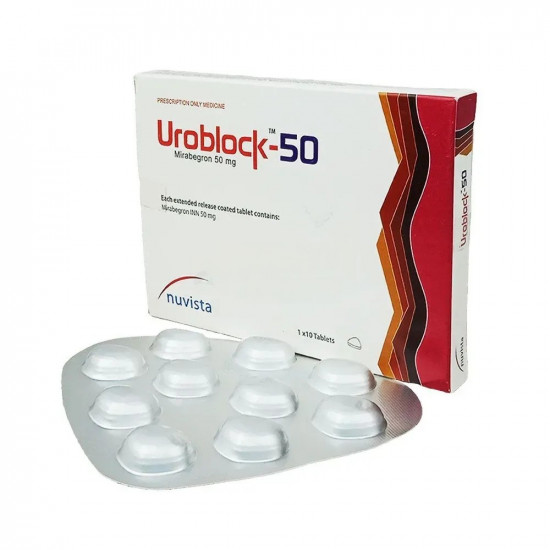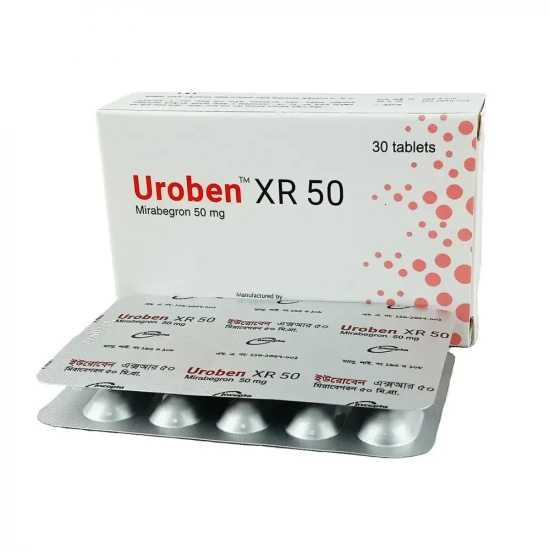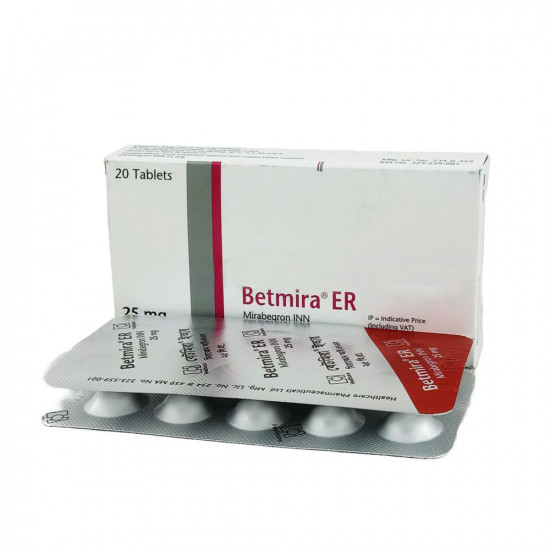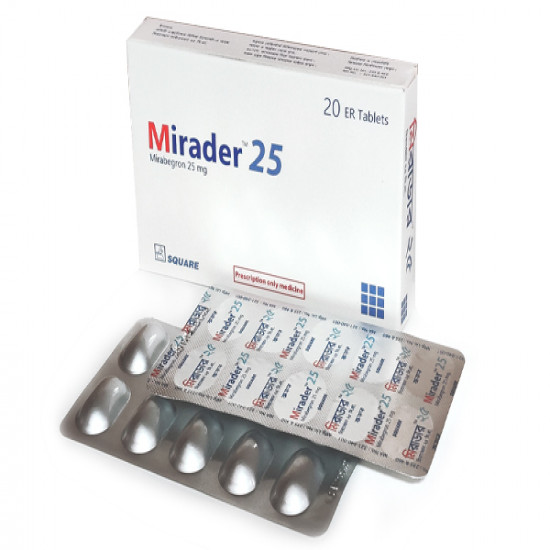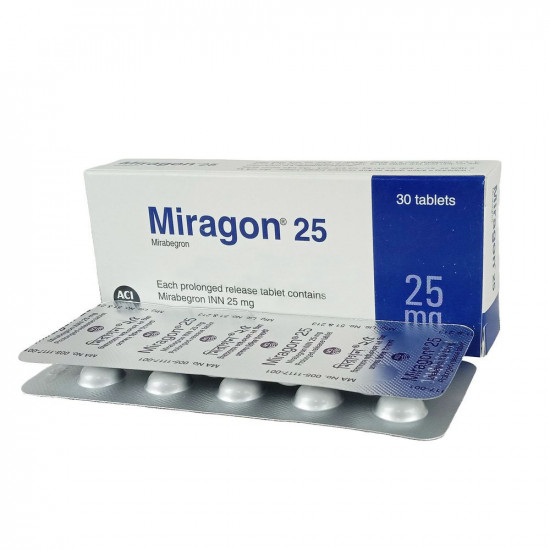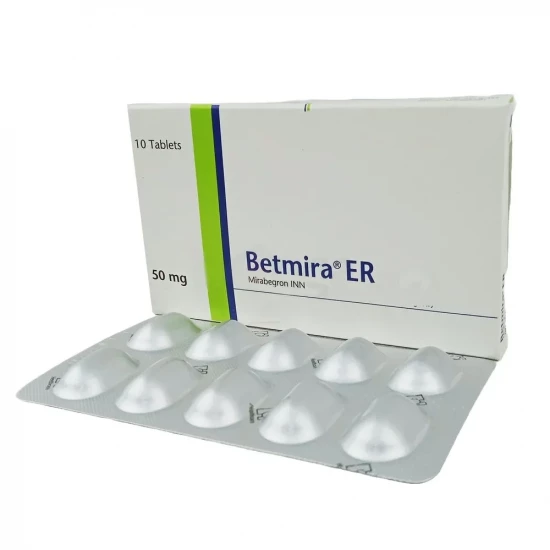
✔ 100% Authentic Product
👁️ Currently Viewing 1355
Betmira ER 50 | 1 Strip
Mirabegron, the active component of Betmira ER, is the first β3-adrenoceptor agonist that acts through a dual mechanism. It directly relaxes the bladder’s smooth muscle and modulates sensory nerve activity.
By stimulating β3-adrenoceptors, Mirabegron increases cyclic adenosine monophosphate (cAMP) levels, causing relaxation of the detrusor muscle during the bladder’s storage phase, which enhances bladder capacity and reduces symptoms of OAB.
Discount
Price: ৳ 517
MRP:
৳
550
6%
Off

100% Genuine Products, Guaranteed

Safe & Secure Payments, Always

Fast, Secure & Efficient Delivery

Proper Packaging
 Cash on Delivery - All over Bangladesh
Cash on Delivery - All over Bangladesh Regular Delivery - 12-24 Hours, Dhaka City* Charge Tk.39-59
Regular Delivery - 12-24 Hours, Dhaka City* Charge Tk.39-59 Regular Delivery - 24-48 Hours, Other Cities* Charge Tk.99-110
Regular Delivery - 24-48 Hours, Other Cities* Charge Tk.99-110
 ফ্রি ডেলিভারিঃ - ৯৯৯ টাকা+ অর্ডারে, ঢাকা
শহরে
ফ্রি ডেলিভারিঃ - ৯৯৯ টাকা+ অর্ডারে, ঢাকা
শহরে ফ্রি ডেলিভারিঃ - ২৯৯৯ টাকা+ অর্ডারে, ঢাকার
বাহিরে
ফ্রি ডেলিভারিঃ - ২৯৯৯ টাকা+ অর্ডারে, ঢাকার
বাহিরে
100% Genuine Products, Guaranteed
Safe & Secure Payments, Always
Fast, Secure & Efficient Delivery
Proper Packaging
 Cash on Delivery - All over Bangladesh
Cash on Delivery - All over Bangladesh Regular Delivery - 12-24 Hours, Dhaka City* Charge Tk.39-59
Regular Delivery - 12-24 Hours, Dhaka City* Charge Tk.39-59 Regular Delivery - 24-48 Hours, Other Cities* Charge Tk.99-110
Regular Delivery - 24-48 Hours, Other Cities* Charge Tk.99-110 ফ্রি ডেলিভারিঃ - ৯৯৯ টাকা+ অর্ডারে, ঢাকা
শহরে
ফ্রি ডেলিভারিঃ - ৯৯৯ টাকা+ অর্ডারে, ঢাকা
শহরে ফ্রি ডেলিভারিঃ - ২৯৯৯ টাকা+ অর্ডারে, ঢাকার
বাহিরে
ফ্রি ডেলিভারিঃ - ২৯৯৯ টাকা+ অর্ডারে, ঢাকার
বাহিরে
✅ Description:
Betmira ER Tablet is prescribed for the symptomatic management of urgency, frequent urination, and urge incontinence associated with Overactive Bladder (OAB) syndrome in adults.
Adults (including elderly):
Initial dose: 25 mg once daily, with or without food.
Based on individual response and tolerance, the dose may be increased to 50 mg once daily.
Renal or Hepatic Impairment:
In patients with severe renal impairment (ClCr/eGFR 15–29 mL/min/1.73m²) or moderate hepatic impairment (Child-Pugh Class B), the dose should not exceed 25 mg once daily.
Betmira ER is not recommended for patients with end-stage renal disease (GFR <15 mL/min/1.73m²), those on hemodialysis, or those with severe hepatic impairment (Child-Pugh Class C).
No dose adjustment is required based on gender.
Safety and efficacy have not been established in patients under 18 years of age.
Administration:
Take the tablet once daily with water. Swallow it whole—do not chew, crush, or divide.
✔️ Side Effects
The most frequently reported side effects during clinical trials (12-week, double-blind, placebo-controlled) were:
Tachycardia – 1.2%
Urinary tract infection (UTI) – 2.9%
Tachycardia led to treatment discontinuation in 0.1% of patients, while UTIs rarely required discontinuation.
Serious but uncommon effects include atrial fibrillation (0.2%).
✔️ Drug Interactions
With enzyme inhibitors:
Co-administration with strong CYP3A/P-gp inhibitors (e.g., ketoconazole, itraconazole, ritonavir, clarithromycin) increases Mirabegron exposure (AUC ↑1.8-fold).
In patients with mild to moderate renal or hepatic impairment receiving such inhibitors, the dose should be limited to 25 mg once daily.
Not recommended in those with severe renal or moderate hepatic impairment taking strong CYP3A inhibitors.
With enzyme inducers:
CYP3A or P-gp inducers (e.g., rifampicin) may reduce Mirabegron levels, though no dose adjustment is typically required.
With CYP2D6 substrates:
Mirabegron moderately inhibits CYP2D6, increasing plasma concentrations of drugs such as metoprolol (Cmax ↑90%) and desipramine (Cmax ↑79%).
Caution is advised with drugs having a narrow therapeutic index metabolized by CYP2D6 (e.g., thioridazine, tricyclic antidepressants, antiarrhythmics).
With P-gp substrates:
Mirabegron weakly inhibits P-gp, slightly increasing digoxin levels (Cmax ↑29%).
Start digoxin at the lowest possible dose and monitor serum levels.
Other interactions:
No clinically relevant interactions were noted with solifenacin, tamsulosin, warfarin, metformin, or oral contraceptives (ethinylestradiol + levonorgestrel).
No dose adjustment is required.
✔️ Betmira ER is contraindicated in patients with:
Hypersensitivity to Mirabegron or any excipients.
Severe uncontrolled hypertension, defined as systolic BP ≥180 mmHg or diastolic BP ≥110 mmHg.
✔️ Pregnancy & Lactation
Human data on Mirabegron use during pregnancy are limited. Animal studies suggest reproductive toxicity; hence, it is not recommended during pregnancy or for women planning to conceive.
Mirabegron has been detected in animal milk and is presumed to be excreted in human milk. Therefore, breastfeeding is not advised during treatment.
No adverse effects on fertility were observed in animal studies, though the effect on human fertility is unknown.
✔️ Precautions & Warnings
- Renal Impairment: Not recommended for end-stage renal disease or severe impairment with concurrent CYP3A inhibitor use. Dose reduction to 25 mg is advised for severe cases.
- Hepatic Impairment: Avoid in severe hepatic impairment; use caution in moderate cases with strong CYP3A inhibitors.
- Hypertension: May elevate blood pressure; monitor regularly, especially in hypertensive patients.
- QT Prolongation: Use cautiously in patients with congenital or acquired QT prolongation.
- Bladder Outlet Obstruction (BOO): Though clinical studies show no increased urinary retention, use with caution in patients with BOO or those concurrently using antimuscarinic agents for OAB.
✔️ Storage:
Store below 30°C, in a cool, dry place, away from light and moisture.
Keep out of reach of children.
⚠️Disclaimer:
At ePharma, we’re committed to providing accurate and accessible health information. However, all content is intended for informational purposes only and should not replace medical advice from a qualified physician. Please consult your healthcare provider for personalized guidance. We aim to support, not substitute, the doctor-patient relationship.




